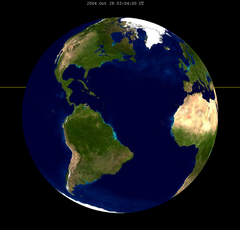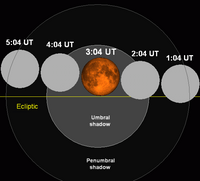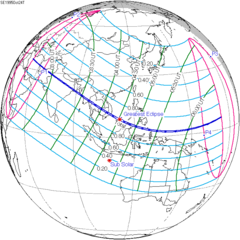October 2004 lunar eclipse
| Total eclipse | |||||||||||||||||
 Totality as viewed from Dunkirk, Maryland at 3:03 UTC, taken by Fred Espenak | |||||||||||||||||
| Date | October 28, 2004 | ||||||||||||||||
|---|---|---|---|---|---|---|---|---|---|---|---|---|---|---|---|---|---|
| Gamma | 0.2846 | ||||||||||||||||
| Magnitude | 1.3100 | ||||||||||||||||
| Saros cycle | 136 (19 of 72) | ||||||||||||||||
| Totality | 85 minutes, 29 seconds | ||||||||||||||||
| Partiality | 218 minutes, 41 seconds | ||||||||||||||||
| Penumbral | 353 minutes, 46 seconds | ||||||||||||||||
| |||||||||||||||||
A total lunar eclipse occurred at the Moon’s ascending node of orbit on Thursday, October 28, 2004,[1] with an umbral magnitude of 1.3100. A lunar eclipse occurs when the Moon moves into the Earth's shadow, causing the Moon to be darkened. A total lunar eclipse occurs when the Moon's near side entirely passes into the Earth's umbral shadow. Unlike a solar eclipse, which can only be viewed from a relatively small area of the world, a lunar eclipse may be viewed from anywhere on the night side of Earth. A total lunar eclipse can last up to nearly two hours, while a total solar eclipse lasts only a few minutes at any given place, because the Moon's shadow is smaller. Occurring about 5.4 days before apogee (on November 2, 2004, at 13:10 UTC), the Moon's apparent diameter was smaller.[2]
This lunar eclipse is the last of a tetrad, with four total lunar eclipses in series, the others being on May 16, 2003; November 9, 2004; and May 4, 2004.
Visibility
[edit]The eclipse was completely visible over much of North and South America, west Africa, and western Europe, seen rising over western North America and the Pacific Ocean and setting over Africa, eastern Europe, and west Asia.[3]

|
 Hourly motion shown right to left |
 The Moon's hourly motion across the Earth's shadow in the constellation of Aries. | |
Gallery
[edit]-
Timelapse photo from Hayward, California
-
Ault Field, Washington, 2:29 UT
-
Dunkirk, Maryland, 3:03 UT
-
From Kiuruvesi, Finland, 3:21 UT
-
Seattle, Washington
End of totality, 3:43 UT -
Bellevue, Washington, 3:51 UT
-
Timelapse photo from A Coruña, Spain
Eclipse details
[edit]Shown below is a table displaying details about this particular solar eclipse. It describes various parameters pertaining to this eclipse.[4]
| Parameter | Value |
|---|---|
| Penumbral Magnitude | 2.36560 |
| Umbral Magnitude | 1.31001 |
| Gamma | 0.28465 |
| Sun Right Ascension | 14h11m00.6s |
| Sun Declination | -13°12'05.3" |
| Sun Semi-Diameter | 16'06.0" |
| Sun Equatorial Horizontal Parallax | 08.9" |
| Moon Right Ascension | 02h10m32.6s |
| Moon Declination | +13°26'29.6" |
| Moon Semi-Diameter | 15'15.1" |
| Moon Equatorial Horizontal Parallax | 0°55'58.4" |
| ΔT | 64.6 s |
Eclipse season
[edit]This eclipse is part of an eclipse season, a period, roughly every six months, when eclipses occur. Only two (or occasionally three) eclipse seasons occur each year, and each season lasts about 35 days and repeats just short of six months (173 days) later; thus two full eclipse seasons always occur each year. Either two or three eclipses happen each eclipse season. In the sequence below, each eclipse is separated by a fortnight.
| October 14 Descending node (new moon) |
October 28 Ascending node (full moon) |
|---|---|
 |

|
| Partial solar eclipse Solar Saros 124 |
Total lunar eclipse Lunar Saros 136 |
Related eclipses
[edit]Eclipses in 2004
[edit]- A partial solar eclipse on April 19.
- A total lunar eclipse on May 4.
- A partial solar eclipse on October 14.
- A total lunar eclipse on October 28.
Metonic
[edit]- Preceded by: Lunar eclipse of January 9, 2001
- Followed by: Lunar eclipse of August 16, 2008
Tzolkinex
[edit]- Preceded by: Lunar eclipse of September 16, 1997
- Followed by: Lunar eclipse of December 10, 2011
Half-Saros
[edit]- Preceded by: Solar eclipse of October 24, 1995
- Followed by: Solar eclipse of November 3, 2013
Tritos
[edit]- Preceded by: Lunar eclipse of November 29, 1993
- Followed by: Lunar eclipse of September 28, 2015
Lunar Saros 136
[edit]- Preceded by: Lunar eclipse of October 17, 1986
- Followed by: Lunar eclipse of November 8, 2022
Inex
[edit]- Preceded by: Lunar eclipse of November 18, 1975
- Followed by: Lunar eclipse of October 8, 2033
Triad
[edit]- Preceded by: Lunar eclipse of December 28, 1917
- Followed by: Lunar eclipse of August 29, 2091
Lunar eclipses of 2002–2005
[edit]| Lunar eclipse series sets from 2002–2005 | ||||||||
|---|---|---|---|---|---|---|---|---|
| Descending node | Ascending node | |||||||
| Saros Photo |
Date View |
Type Chart |
Gamma | Saros Photo |
Date View |
Type Chart |
Gamma | |
| 111 | 2002 May 26
|
penumbral
|
1.1759 | 116 | 2002 Nov 20
|
penumbral
|
−1.1127 | |
121
|
2003 May 16
|
total
|
0.4123 | 126
|
2003 Nov 09
|
total
|
−0.4319 | |
131
|
2004 May 04
|
total
|
−0.3132 | 136
|
2004 Oct 28
|
total
|
0.2846 | |
| 141 | 2005 Apr 24
|
penumbral
|
−1.0885 | 146
|
2005 Oct 17
|
partial
|
0.9796 | |
| Last set | 2002 Jun 24 | Last set | 2001 Dec 30 | |||||
| Next set | 2006 Mar 14 | Next set | 2006 Sep 07 | |||||
Saros 136
[edit]This eclipse was a part of Saros cycle 136. The next occurrence will be on 8 November 2022. Solar Saros 143 interleaves with this lunar saros with an event occurring every 9 years 5 days alternating between each saros series. The greatest eclipse will occur on 21 April 2293, lasting 101 minutes and 23.5 seconds. The last total lunar eclipse will be on 7 July 2419 and the last partial lunar eclipse on 3 October 2563. The final lunar eclipse of Lunar Saros 136 will be on 1 June 2960.
Metonic series
[edit]This eclipse is the third of four Metonic cycle lunar eclipses on the same date, 28–29 October, each separated by 19 years:
The metonic cycle repeats nearly exactly every 19 years and represents a Saros cycle plus one lunar year. Because it occurs on the same calendar date, the Earth's shadow will in nearly the same location relative to the background stars.
| Metonic events: May 4 and October 28 | |
|---|---|
| Descending node | Ascending node |
|
|

|

|
Half-Saros cycle
[edit]A lunar eclipse will be preceded and followed by solar eclipses by 9 years and 5.5 days (a half saros).[5] This lunar eclipse is related to two solar eclipses of Solar Saros 143.
| October 24, 1995 | November 3, 2013 |
|---|---|

|

|
See also
[edit]- List of lunar eclipses and List of 21st-century lunar eclipses
- May 2003 lunar eclipse
- November 2003 lunar eclipse
- May 2004 lunar eclipse
Notes
[edit]- ^ "October 27–28, 2004 Total Lunar Eclipse (Blood Moon)". timeanddate. Retrieved 13 November 2024.
- ^ "Moon Distances for London, United Kingdom, England". timeanddate. Retrieved 13 November 2024.
- ^ "Total Lunar Eclipse of 2004 Oct 28" (PDF). NASA. Retrieved 13 November 2024.
- ^ "Total Lunar Eclipse of 2004 Oct 28". EclipseWise.com. Retrieved 13 November 2024.
- ^ Mathematical Astronomy Morsels, Jean Meeus, p.110, Chapter 18, The half-saros
External links
[edit]- NASA
- Total Lunar Eclipse of Oct. 27, 2004
- 2004 Oct 28 chart: Eclipse Predictions by Fred Espenak, NASA/GSFC
- Saros series 136
- NASA Astronomy Picture of the Day: Red Moon Triple (29 October 2004)
- NASA Astronomy Picture of the Day: Pumpkin Moon (30 October 2004)
- Lunar Eclipse gallery
- Photo by Wade B Clark Jr. near Lyman, Washington, USA
- [1]
- Spaceweather.com: Lunar eclipse gallery










